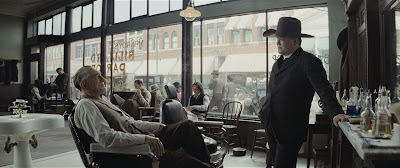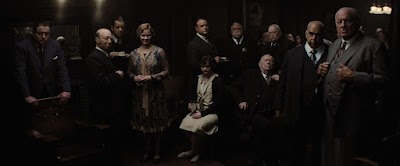or
The Conformist of the Plains
David Grann's output of articles and books has provided fodder for lots of movies: The Lost City of Z, Dark Crimes, The Old Man and The Gun, Trial By Fire, and now Killers of the Flower Moon (with its director, Scorsese's next film to be based on Grann's latest book "The Wager"). Grann wrote his book about a moment of long forgotten history—The Osage Indian Murder Case, what the newspapers at the time called "The Reign of Terror" from 1918 to 1931. It was one of the first murder cases taken over and solved by the nascent Bureau of Investigation, what would soon become acronymed as the FBI, an attempt to coordinate crime data into a national data resource that could be shared amidst the disparate state jurisdictions and law enforcement agencies.
Grann's book is a fine read—it spent 49 weeks on the New York Times non-fiction best-seller list—breaking down the story into three narratives: of Mollie Burkhart (played in the film by Lily Gladstone) of the Osage Tribe, who saw three of her sisters and her mother die (under suspicious or downright murderous circumstances) in a short space of a few years; of Tom White (played in the film by Jesse Plemons), a former Texas Ranger, recruited by the Bureau to investigate the murders—his unique way of assembling a team and having them blend in with the community was a bit unpracticed, but did lead to convictions; and a modern post-investigation appraisal. When Martin Scorsese announced it for his next movie with Robert De Niro and Leonardo DiCaprio starring it was originally just going to focus on the FBI investigation with DiCaprio as White.But DiCaprio had other ideas—he wanted to play "a villain" and so the film was re-tooled by Scorsese and Eric Roth to feature more of the role of Ernest Burkhart, husband of Mollie and his role in the web of deceit and murders...all to obtain the headrights (the land mineral rights owned by full-blooded Osage tribe-members) to their oil-rich pocket of Oklahoma, that made the Osage "the wealthiest people per capita" in the nation. The Osage became prosperous with their oil stipend, creating a power dynamic where they ostensibly ran things in Fairfax, Oklahoma, but they were also targets for any scam and flim-flam the other residents could concoct in order to benefit from their prosperity.
And that included marrying into the money, the oldest way for profligate men to get a sustainable nest-egg and not waste it all in a short period of time. If there's children, then there's always inheritance, or better yet, the idealistically labeled "trust-fund," that can be exploited as long as no one is following the trail of money. In Fairfax, Oklahoma, the trail was not only monetary, but one merely had to trace family ties and the obituary column to see that something was surfacing besides oil.Clocking in at a back-breaking 3 hours 20 minutes, Killers of the Flower Moon begins where most Scorsese movies do, following the bad guys. Ernest Burkhart (DiCaprio) exits the train to Fairfax after serving in the First World War and receives a warm welcome from his uncle, cattleman William Hale (De Niro), who is perfectly agreeable to taking Ernest under his wing, despite his lack of experience. Under an avuncular pretense, Hale gives his nephew the lay of the land, giving him a book on the Osage people ("Do you read?") and asking pointed questions about his taste in women. Hale speaks the Osage language and extends his avuncular charm to express support for the Native land-owners, especially dealing with the white city officials, the police and Sheriff, the local doctors, even the undertaker (that'll come in handy!). He also is quite familiar with the local underworld (even handier!), and his network makes him less than a town father, and more of a puppet-master.
Burkhart is his primary puppet, lending support to a romance between Ernest and Mollie Kyle (Underwood, who in her mandarin understated way, steals the show as well as hearts), who is already seeing signs of poor health in her family, who have a tendency towards diabetes. And when a "specialist" is needed for some special work to be done, Hale uses his nephew as a go-between, the better to keep his immaculate hands clean.
But, the center cannot hold. In the community, the deaths become less and less isolated and more overt, culminating in a house-bombing that kills Mollie's sister and her husband, who has been asking questions and connecting dots, while resisting any overtures to share information with Ernest. That signs his death warrant and the egregiousness of the crime—the sheer audacity of it—mandates outside help. Private detectives had been hired before...but had disappeared never to be heard from again. A meeting between tribes leaders and President Calvin Coolidge allows Mollie to make an entreaty...and for once, the Great White Father keeps his word.
This is where Plemons' Tom White from the Bureau of Investigation comes into town from Washington, and it only takes a couple of inquiries to determine that he's being stone-walled...by everybody. Evidence goes missing, records disappear, stories are vague and sometimes conflicting. But White brings in some other agents with varying backgrounds to infiltrate the town and integrate themselves into both the White and Native communities. Then, they share information and find the links...and discrepancies. And they attack from within.
If the film has a fault in conception, it is in the sheer repetitiveness of the crimes (although, to be clear, the crimes DID happen as depicted and over that long period of time, which shows how frustratingly slow any shred of justice could be brought to so insular and complicit a community). But, the numbing volume of the crimes strains credulity and patience for an audience, even one used to the slow process of justice and the bull-headedness that passes for politics but stinks like conspiracy. Not to minimize the scope of the crimes, but to see every one of them played out through the machinations of Hale through the prevarifications of DiCaprio's Burkhart makes it a long stretch of the same thing repeated over and over.
Gladstone is the acting highlight of the film, and De Niro—although a bit too long in the tooth to be playing Hale—does a good turn as evil posing as the friendly neighbor.
DiCaprio, though, is an issue. Sure, he's good box-office (and he's an Executive Producer on the film), but it may be time for the long string of Scorsese collaborations to end. At times, one can see him using Brando tricks and an occasional Jack Nicholson strategy in his acting, but mostly he seems to have based his performance on a frowny-face emoji (😠). His face freezes into the same petulant scowl, no matter the circumstances, whether he's unhappy, concerned, frustrated, murderous or cornered. And, the deeper you get into the movie, the lower the corners of his mouth drop until you wonder if his jaw will just drop off once they carve far enough. It's a disappointing performance, considering how integral DiCaprio made himself to the film.

It may be time to kick him off the raft, Marty.
Still, Killers of the Flower Moon resonates, as one more early example of a nation's systemic racism hiding in the shadows and swept under the rug, something that, although denied in all corners of the continuing national reckoning, continues to raise its ugly head.















.jpg)


No comments:
Post a Comment